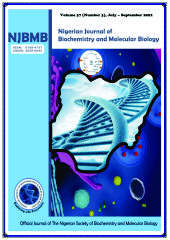A Comparative Study on the Effect of Honey and Sucrose Rich Diet on Key Tissue-Organ Function of Wistar Rats
Abstract
Natural honey is considered a better alternative to table sugar, and particularly the Obudu Cattle Ranch honey that supplies much of the Nigerian markets. This work compared the effect of table sugar and the Obudu honey-sweetened diets on the functions of key organs of Wistar rats. Equivalent calories of the sweeteners were fed to 5 groups of rats: Normal control, 15% sugar, 30% sugar, 12% honey and 24% honey for 13 weeks. Food consumption and blood indices of liver, kidney and hematopoietic functions were determined. The results obtained show no marked effect of both sweeteners on measured liver function indices. Compared to the honey-based diet, the sugar-sweetened-diet did not cause any significant change in kidneys and blood functions. However, compared to the control, S15% diet was found to cause a 3.36% and 31.29% increase in serum sodium and chloride levels, respectively (P ˂ 0.05). Similarly, the H12% and H24% diets caused 19.77% and 34.09% increase in serum potassium concentration and white blood cells counts respectively, relative to the control (P ˂ 0.05). Therefore, natural honey may not have any advantage over table sugar in regards to tissue/organ functions and vice versa.
Downloads
References
Atangwho, I. J., Edet, E. E., Uti, D., Obi, A. U., Asmawi, M. Z. and Ahmad, M. (2012). Biochemical and histological impact of Vernonia amygdalina supplemented diet in obese rats. Saudi Journal of Biological Sciences, 19:85-392.
Bogdanov, S., Jurendic, T., Sieber, R. and Gallmann, P. (2008). Honey for nutrition and health: a review. Journal of American College of Nutrition, 27:677- 689.
Center for Disease Control (CDC) (2022). Overweight and obesity, (obesity basic). Retrieved on 20 August 2022, from https://www.cdc.gov/obesity/basics/causes.html
Chepulis, L. (2007). The effects of honey compared with sucrose and a sugar-free diet on neutrophil, phagocytosis and lymphocyte numbers after long-term feeding in rats. Journal of Complementary and Integrative Medicine, 4:1-7.
Chepulis, L. and Starkey, N. (2008). The long-term effects of feeding honey compared with sucrose and a sugar-free diet on weight gain, lipid profiles and DEXA measurements in rats. Journal of Food Science,73(1),1-6.
Choudhary, A. and Deevi, R. (2014). Serum biochemical responses under oxidative stress of aspartame in wistar albino rats. Asian Pacific Journal of Tropical Diseases, 4(1): 403-410.
Dovey, D. (2015). Sugar addiction doesn’t just lead to obesity it affects your heart health, brain function and even your sex life. Retrieved April 1, 2015 from: www.medicaldaily.com.
Erejuwa, O., Sulaiman, S. and Wahab, M. (2012). Fructose might contribute to the hypoglycemic effect of honey. Molecules, 17(2): 1900-1915.
Eteraf-Oskouei, T. and Najafi, M. (2013). Traditional and modern use of natural honey in human diseases: A review. Iranian Journal of Basic Medical Sciences, 16: 731-742.
Ford, N. D., Patel, S. A., and Narayan, K. M. V (2017). Obesity in low- and middle-income countries: burden, drivers, and emerging challenges, Annual Review of Public Health, 38(1):145–164.
Fox, S. (2011). Human Physiology, 12th ed. pp. 401-681.Iowa: McGraw-Hill Company.
Hodgson, E. (2004). A textbook of modern toxicology (3rd ed) (pp. 263-320). New Jersey: John Wiley & sons Inc.
Kappico, J., Suzuki, A. and Hongu, N. (2012). Is honey the same as sugar? Arizona: College of Agriculture and Life Sciences Cooperative Extension.
Kim, H., Kang, H., Seo, J., Lee, C., Kim, Y. and Kim, J. (2011). Anti-obesity effect of oil extract of Ginseng. Journal of Medicinal Foods, 14(6): 573-583.
Li, S., Zhang, H., Hu, C., Lawrence, F., Gallagher, K., Surapaneni, A., Estrem, S., Calley, J., Varga, G., Dow, E. and Chen, Y. (2012). Assessment of diet-induced obese rats as an obesity model by comparative functional genomics. Obesity and Research Journal, 16(4):811-818.
Morakinyo, A., Adekunbi, D., Dada, K. and Adegoke, O. (2013). Coffee consumption attenuates insulin resistance and glucose intolerance in rats fed on high-sucrose diet. Nigerian Journal of Physiological Sciences, 28:179 -185.
Murray, R., Bender, D., Botham, K., Kennelly, P., Rodwell, V. and Weil, P. (2012). Harper’s illustrated Biochemistry, 29th ed. pp. 150-248. New York: McGraw-Hill Company.
Nelson, D. and Cox, M. (2013). Lehninger Principles of Biochemistry, 6th ed. pp. 938-971. New York: W. H. Freeman and Company.
Noeman, S., Hamooda, H. and Baalash, A. (2011). Biochemical study of oxidative stress markers in the liver, kidney and heart of high-fat diet induced obesity in rats. Diabetology and Metabolic Syndrome, 3:17.
Onyije, F., Avwioro, O., Atoni, A., Nduka, A. and Zenebo, V. (2012). Evaluation of the kidney following administration of unprocessed honey in Wistar rats. Asian Journal of Medical and Pharmaceutical Researches, 2(1):21-25.
Perez-Rodrigo, C. (2013). Current mapping of obesity. Nutrición Hospitalaria, 28(5):21-31.
Rogers, K. (2011). Blood: Physiology and Circulation (Ist ed.) (pp. 61-200). New York: Britannica educational publishing.
Sheriff, M., Tukur, M., Bilkisu, M., Sera, S. and Falmata, A. (2011). The effect of oral administration of honey and glucophage alone or their combination on the serum biochemical parameters of induced diabetic rats. Research in Pharmaceutical Biotechnology, 3(9):118-122.
World Health Organization (WHO) (2021). Obesity and Overweight, (WHO factsheet). Retrieved on August 20, 2022, from https://www.who.int/news-room/fact-sheets/detail/obesity-and-overweight.
Additional Files
Published
Issue
Section
Categories
License
Copyright (c) 2022 Ime F. Ani, Margaret A. Eno, Eyuwa I. Agwupuye, Abdulhakeem R. Agboola, Item J. Atangwho

This work is licensed under a Creative Commons Attribution-NonCommercial 4.0 International License.


